This article may contain links to products and services we use and recommend. We may receive compensation when you click on links to those products. For more information, see our Disclosure Policy.
Exploring Lisbon reminded us a few times of our travels on the other side of the Atlantic: from the Ponte 25 de Abril suspension bridge [Google Maps location], whose larger sister greets seafarers entering San Francisco Bay, to Cristo Rei [Official website, Google Maps location], who blesses the city with outstretched arms just like Christ the Redeemer in Rio de Janeiro. But there is more to the Portuguese capital than famous look-a-like landmarks.
If you’re here because you’re after affordable things to see and do in/around Lisbon (that are not in every guidebook), or experiences that give you an an insight into local life and help support local communities, here are our tips for Lisbon and Sintra. Enjoy!
Planning your trip to Lisbon and Sintra last minute?
Book your transportation to/from and around Lisbon, keeping your carbon footprint in mind:
Find your perfect accommodation in Lisbon and Sintra with Booking.com. We recommend these traditional, small-scale and centrally located options near public transport:
Lugggage Storage
Need a secure place to store your luggage before check-in or after check-out? We've partnered with Bounce, the world's largest luggage storage network, to offer safe and convenient storage locations in over 100 cities worldwide, starting at just USD 5 per day. Enjoy free cancellation, USD10,000 protection, and 24/7 customer support for peace of mind while you explore. Book now.
Airport Transfers
Book reliable airport transfers in advance for peace of mind. With Suntransfers, enjoy door-to-door service at 500+ airports worldwide. Professional drivers, real-time flight tracking, flexible booking options, and 24/7 support ensure a smooth journey from the moment you land.
We use and recommend Airalo eSIMs for affordable, hassle-free internet access in 200+ destinations. Activate before you arrive and get online instantly.

Lisbon's 25 April Bridge was built by the same company as its larger sister in San Francisco | Image courtesy of rognar / Canva
Map of Accommodation, Points of Interest, Eateries and Transport
Below is a map of the recommended accommodations, points of interest, eateries, and transport terminals or stops mentioned in this article.
1. Explore Lisbon’s neighbourhoods by public transport and on foot
Thinking of driving around Lisbon? Think again. We wouldn’t even recommend driving to Sintra.
Lisbon has an excellent and very affordable public transportation system, consisting of buses, suburban and subway trains, trams, and even funiculars that save you from having to climb steep streets.
If you plan a road trip around Portugal, and Lisbon is your starting point, pick up your rental car once you’re ready to leave the area.
To use Lisbon’s public transport, it’s best to obtain the Navegante occasional card (formerly known as the Viva Viagem card) and load some money onto it. Then, tap the card on the card reader as you enter the metro, train station, bus, tram, etc. (this is called ‘zapping’ here). Each journey is significantly discounted, and you only pay once, even if you change buses, as long as the change occurs within the hour. You can even use the card’s zapping/pay-as-you-go feature on the historic trams, the Santa Justa Lift / Elevador de Santa Justa [Google Maps location] and the trains to Cascais and Sintra.
You can buy the card (EUR0.50) and top it up at any metro/train station and at designated sales points (use the free Wi-Fi provided on most buses, and the Carris website will appear with a sales points search option to find one near you). The minimum top-up is EUR3.00. You won’t be able to get a refund, so don’t put more on the card than you need. The card itself is valid for a year.

You can use the navegante® occasional card and zap/pay-as-you-go even on the old trams and historic funiculars
For a more local perspective on Portugal’s capital city, we recommend starting your stay with a complimentary guided walking tour. The Tours Of My Life leave daily from Luís de Camões Square / Praça Luís de Camões [Google Maps location]. The tours last approximately three hours and showcase a less touristy side of the Bairro Alto, Chiado, Baixa, and Alfama neighbourhoods. By the way, these tours are technically free, but if you enjoyed them, please consider giving your guide a generous tip. Below are some other options.
2. Travel back in time and learn about the early history of the city
Lisbon has been around for several millennia. That’s right. You won’t see it as you wander the city centre today, as almost all the buildings were built after 1755. Why? On 1 November 1755, the city was nearly destroyed by a massive earthquake, followed by a tsunami and fires that lasted for weeks. A new town was built on top of the rubble, featuring a grid-like streetscape that can still be seen today.
Hidden underneath the grand 18th-century buildings are the ruins not only of a Medieval city, a Moorish city, and a Roman city, but also remnants of a much older civilisation —2,500 years old. To dive into Lisbon’s early history, book yourself into one of the free tours that are held hourly (in English) by the Fundação Millennium BCP [Google Maps location] in Baixa. The tours (about 45 minutes long) take you through the archaeological excavations underneath the Millennium BCP building. Fascinating.

Archaeological excavations under the Millenium BCP Building in Baixa showcase 2500 years of human settlement in Lisbon
3. Learn about Portugal’s Golden Age
Speaking of history… Did you know that the Portuguese were once a dominant maritime power? We have all heard of names like
- Magellan/Fernão de Magalhães – the Strait at the bottom of South America, which he was the first to sail, still bears his name – or
- Vasco da Gama, who discovered the sea route to India around the Cape of Good Hope.
The Portuguese discoveries of the 15th and 16th centuries not only brought immense riches to the tiny Kingdom of Portugal, thanks to colonisation and slavery, but also significantly advanced maritime technology and cartography.

Many of the world maps we use today were first drawn during the Portuguese discoveries of the 15th and 16th centuries
Lisbon’s neighbourhood of Belém, in particular, is intricately linked to the discoveries:
- Those whose ship was about to leave for distant, unknown lands stayed at Jerónimos Monastery [Google Maps location] to be blessed for their journey and to pray for a safe return.
- The Belém Tower [Google Maps location] was the last feature the seafarers saw when they left (and the first when they returned home).
Quite fittingly, the 56 meters high Monument to the Discoveries [Google Maps location] was placed on the shores of the Rio Tejo not far from the Belém Tower.
You can learn all about Portugal’s maritime history at the Lisbon Maritime Museum [Google Maps location], located next to Jerónimos Monastery. The museum also houses the original of another notable discovery: the first plane to cross the South Atlantic in 1922 (the monument can also be found near the Belém Tower).
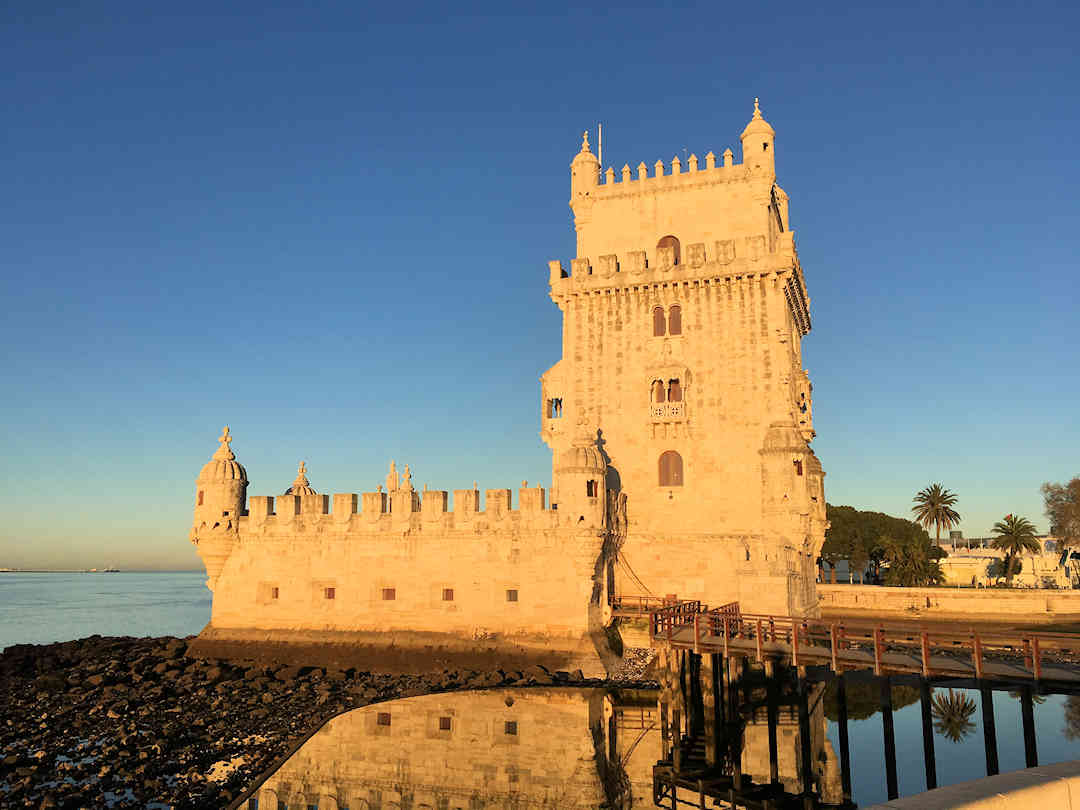
The Belém Tower was the last feature seafarers saw when they left Lisbon (and the first when they returned home)
| Name | Property Features | Type | Price Indicator | Book Now |
|---|---|---|---|---|
| Belem Family Apartment | Free parking Non-smoking Washing Machine | One bedroom apartment | $$$ | Book Now |
| Lisbon Luxury Studio | Recently Renovated Washing Machine Free parking | Studio | $$$ | Book Now |
| Snug Independent Room Lisbon | Three stars Family Room with Private Bathroom Fully equipped kitchenette | Studio | $$ | Book Now |

Tiled façades are everywhere in Lisbon's old town and can be discovered while walking around the city | Image courtesy of annault from Getty Images / Canva
4. Enjoy the views from the various look-out points dotted around the city
If you haven’t noticed it by now, Lisbon is built on and around several hills. While that means exploring the city entails climbing some steep streets, it also means you’ll find beautiful views everywhere.
Every neighbourhood seems to have its own lookout point (miradouro), and you don’t have to pay an entry fee to enjoy the views. Here are just a few examples we have visited:
- Alfama: Miradouro de Santa Luzia [Google Maps location] and Miradouro das Portas do Sol [Google Maps location]
- Bairro Alto: Miradouro de Santa Catarina [Google Maps location]
- Graça: Miradouro da Nossa Senhora do Monte [Google Maps location].

The Belém Tower is not the only spot for great views over Lisbon - Try some of the many look-out points along Lisbon's hills
The 18th-century aqueduct in Campolide, Aqueduto das Águas Livres [Google Maps location], which survived the 1755 earthquake unscathed, is not a lookout point as such (and it is not free). However, for a small entry fee (EUR3.00 at the time of writing), you can walk along the top of the aqueduct towards Monsanto Park (unfortunately, you can’t enter the park from the aqueduct) and enjoy great views over the Alcântara Valley to the 25 April Bridge and the Cristo Rei statue across the river.
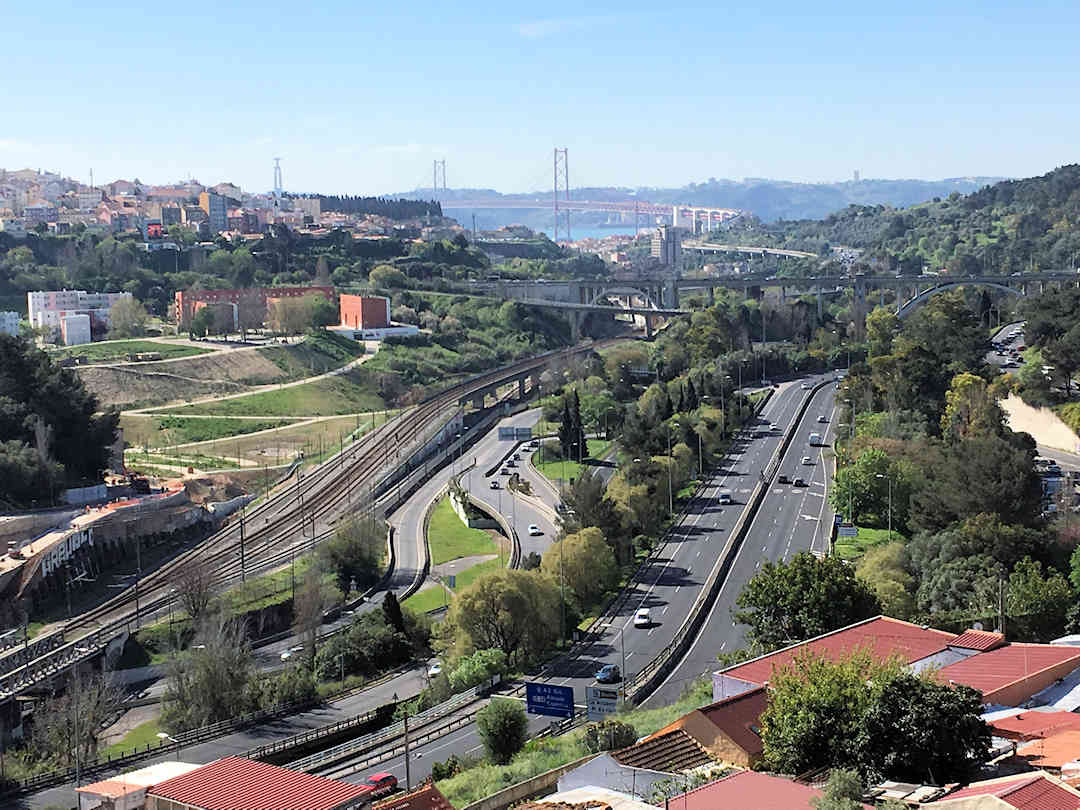
You can even walk across an 18th-century aqueduct and enjoy these views of the Alcântara Valley
The lookout points are also great for a romantic picnic at sunset, though you’ll share your spot with a gazillion locals and tourists. If you prefer to enjoy your sunset while seated at a private table with a glass of sangria and some tapas (or a proper dinner), try Chapitô à Mesa [Google Maps location] in Alfama or Noobai [Google Maps location] in Bairro Alto.
Which brings us to our number 5…
5. Taste traditional Portuguese cuisine
Our tips usually involve some walking or hiking, and here in Portugal, you’ll need those to avoid piling on the pounds…. because the food here is delicious. Seafood is fresh (apart from Mondays apparently as the fishermen take Sundays off), and every town seems to have its traditional pastries.

Make sure you taste some of the fresh seafood dishes while in Lisbon
So, venture off the tourist trail into the quiet side lanes and choose a restaurant full of locals (avoid those with big groups as you may wait forever to be served). The menu may be scribbled on a piece of paper, or there may be no menu at all. No worries. Just ask the waiter/waitress for the plate of the day (O Prato do Dia). Usually, a choice between a fish and a meat dish, the portions will fill you up and will not burn a hole in your wallet.
We had yummy fish dishes at Sossego [Google Maps location] and O Navegador [Google Maps location], both in Belém, as well as Zé dos Cornos in Mouraria, the Moorish Quarter [Google Maps location] and A Provinciana [Google Maps location] near Praça dos Restauradores.
If you’re after a delicious fish snack, try Bolinhos de Bacalhau, croquettes made with codfish. Or join one of our recommended food tours to sample a whole array of traditional Portuguese dishes (often accompanied by wine from the nearby wineries):
By the way, waiters always place bread, butter, olives, and the like on your table when you sit down. Unless they are part of the plate of the day, you have to pay for those if you eat them. If you gesture to them that you don’t want them, they’ll take them away. You also won’t be charged if you leave them on the table untouched.

Pastéis de Belém still has the best Portuguese Tarts we have tasted in Lisbon - Come early to avoid the hoards of tourists
As for pastries… Taste Pastéis de Nata (also known as Portuguese Tarts), where they originated: at Pastéis de Belém [Google Maps location]. Come early (they open at 0800h) as this place is packed with tourists for most of the day. Admittedly, it is super touristy, but the tarts are the best we’ve had so far (and we’ve had at least one a day in different locations).
If you visit Sintra (see below), make sure you taste traditional pastries from Sintra, such as
- Travesseiros (small pillow-shaped pastries), for example, at Casa Piriquita [Google Maps location] or
- Queijadas (little cheese pastries), for example, at Casa do Preto [Google Maps location], which bakes them onsite.
And if you happen to visit Sintra on the second or fourth Sunday of the month, make sure you check out the Feira de São Pedro de Sintra [Google Maps location]. It’s open until 17:00, so you can still pop by after a day of exploring the castles. Try chorizo bread fresh out of the oven or some of the yummy cheeses and hams for sale at the various stalls.

If you visit Sintra on the 2nd or 4th Sunday of the month, try freshly baked chorizo bread at the Feira de São Pedro de Sintra
6. Visit Sintra (plus Cabo da Roca and Cascais)
Speaking of Sintra… Yes, it is full of tourists, especially day trippers who come here by the busloads from Lisbon. But if you come in Spring or Autumn, it’s not quite as busy as in the height of Summer. Additionally, there is so much to see and do around here that it’s worth staying a few nights.
Not sure which sight/s to choose? That’s a hard one because they are all unique. We visited these three and liked all of them for different reasons:
- Parque e Palácio Nacional da Pena [Google Maps location] is renowned for its unique blend of colours and styles, its stunning park, and its breathtaking views.
- The Moorish Castle / Castelo dos Mouros [Google Maps location] is worth visiting for its history (it was built in the 10th Century and has recently undergone significant restoration), the beauty of the structure (we felt a bit like climbing the Great Wall of China), and its beautiful views.
- Quinta da Regaleira [Google Maps location] for its fairy tale character. It is packed with labyrinthic grottoes, fountains, towers and turrets, even a greenhouse and a chapel, and the Palace of the Carvalho Monteiro family itself.
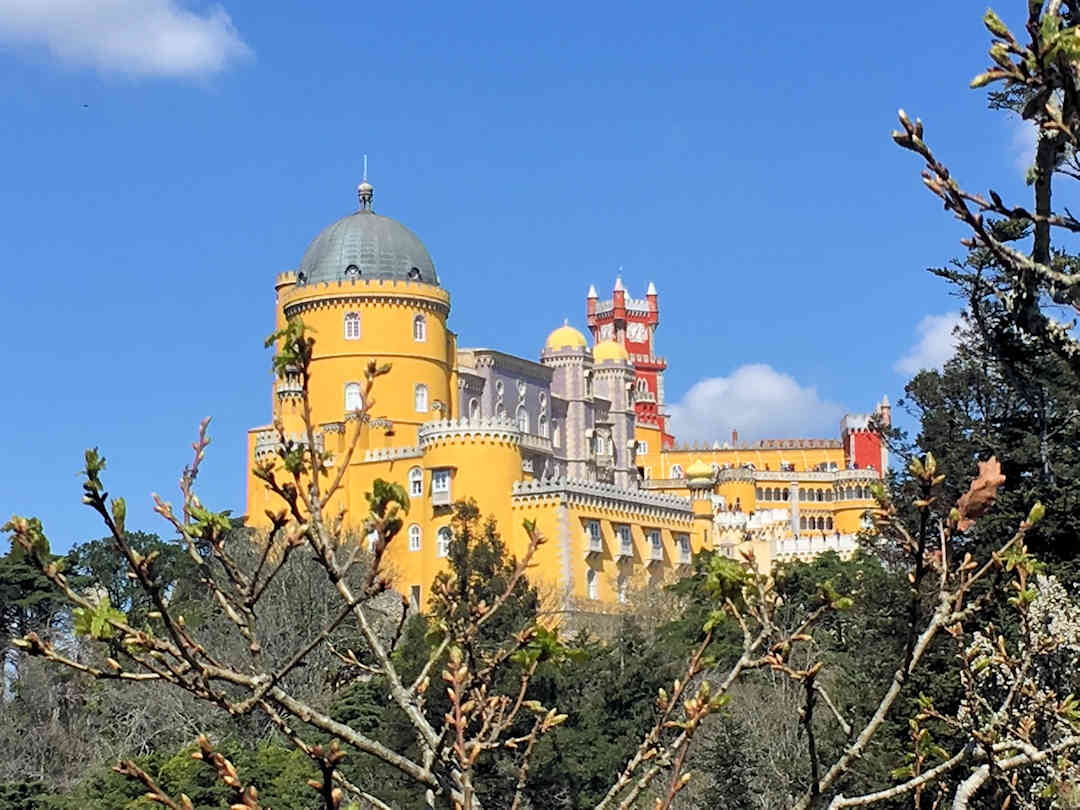
Colourful Pena Palace with its surrounding park is just one of the many places to explore in Sintra
By the way, if you plan to visit Pena but find the entrance fee for the park and palace a bit steep, we recommend skipping the palace, especially if you’ve seen (or will see) other castles around Europe. Instead, take your time exploring the gorgeous park and don’t forget to hike up to Cruz Alta [Google Maps location], the highest point in the Sintra Mountains, for 360-degree views.
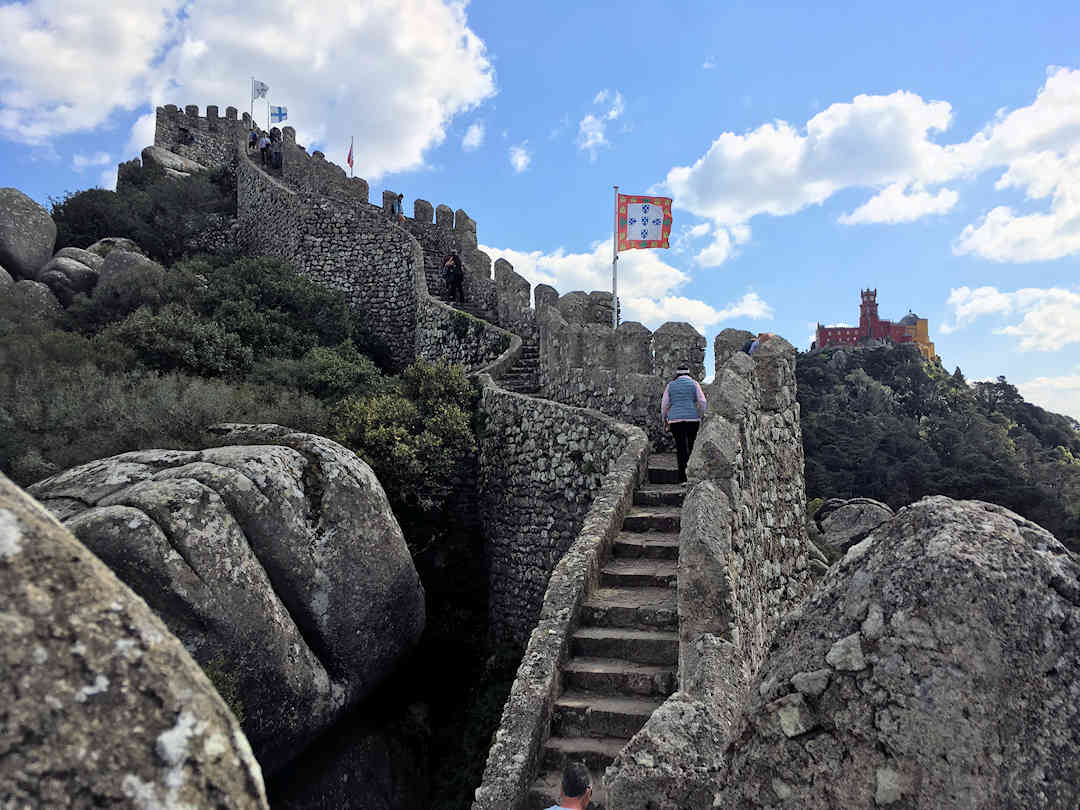
Climbing the towers and walls of Sintra's majestic Moorish Castle is a bit like visiting the Great Wall of China
If you plan to visit several of Sintra’s sights, you can buy your tickets online all at once (and at an additional discount on top of the online discount). If you want to visit two sights on day 1 and two other sights on day 2, select the respective dates accordingly during the booking process.
Day Trip Itinerary for Sintra
If you only have time for a day trip, we recommend starting at Pena (when it opens), then heading over to the Moorish Castle. After lunch in the historic town centre, check out one of the other sights: Quinta da Regaleira, Monserrate, or the National Palace of Sintra. It’s a packed day, though.
2-3 Day Sintra Itinerary (with optional trip to Cabo da Roca and Cascais)
If you can stay a few nights, we recommend the following itinerary:
- Day 1: Explore the park around Pena Palace and the Moorish Castle. Hike up instead of taking the overpriced and jam-packed tourist shuttle. If you start early, you’re still there before the day-trippers from Lisbon arrive. The castles open at 09:30.
- Day 2: Explore Quinta da Regaleira, Monserrate or the National Palace of Sintra.
- In the afternoon of Day 2 or on Day 3, take the bus from Sintra’s train station to Cabo da Roca, the westernmost point of the European mainland, and after exploring the area, on to Cascais. After exploring Cascais, take the bus back to Sintra. Alternatively, you can take the train directly from Cascais back to Lisbon.

There are no words for the fairy tale of Quinta da Regaleira - you have to see it for yourself
Where to stay in Sintra?
We recommend staying in Sintra for (at least) 3 nights/2 full days of exploration. Our accommodation recommendations are in easy reach of the main sights AND affordable:
| Name | Property Features | Type | Price Indicator | Book Now |
|---|---|---|---|---|
| Casa do Briamante 9 | Washing machine | Apartment | $$$ | Book Now |
| Casa d Sintra | Certain documented environmental practices implemented at property | Apartment | $$ | Book Now |
| Casa Wanderlust | Certain documented environmental practices implemented at property Non-smoking rooms | Apartment | $$$ | Book Now |
| Casinha Amarela | Family rooms Non-smoking rooms | Homestay | $$ | Book Now |
7. Join a more affordable bridge experience
Unlike its bigger sister in San Francisco, the 25 April Bridge [Google Maps location] cannot be crossed by pedestrians (or cyclists) unless you are running the Lisbon Half-Marathon, which starts on the south banks of the Rio Tejo and takes runners across the bridge.
The second best thing, especially if you have a knack for engineering and architecture, and you’re not scared of heights, is the Pilar 7 Bridge Experience. It tells you all about the history of the 25 April Bridge, takes you up to the bridge’s road level for spectacular views, and thanks to VR (virtual reality) goggles, you can even join a maintenance crew on their inspection tour around the bridge. At less than 10 euros, this bridge experience is significantly more affordable than the one in Sydney.

The Pilar 7 Bridge Experience is not for the faint-hearted
8. Enjoy Lisbon’s gigantic green lung
Did you know that Lisbon has one of the largest parks in Europe? You will notice Monsanto Park / Parque Florestal de Monsanto [Google Maps location], the giant green area in the middle of the urban sprawl, when you fly in.
The park is excellent for walking, running or mountain biking. Bring a picnic and check out the abandoned Panoramic restaurant, also known as Panorâmico de Monsanto [Google Maps location], for fantastic views over the city.

Lisbon's Monsanto Park is a great spot to take your loved ones for a walk, bike ride or picnic | Image courtesy of studiof22byricardorocha from Getty Images, Canva
9. Appreciate Lisbon’s street art
It’s worth taking a moment to admire Lisbon’s stunning tiled façades. There is also great graffiti street art everywhere… You need to keep your eyes open. We stumbled upon some great artwork
- across several abandoned buildings near Picoas metro station,
- along a wall by the Amoreiras intersection,
- at LX Factory, and
- at several of the stairs leading up to the Castelo de São Jorge.
These are the more obvious murals, though. If you want to get truly off the beaten path, join one of these great street art tours:
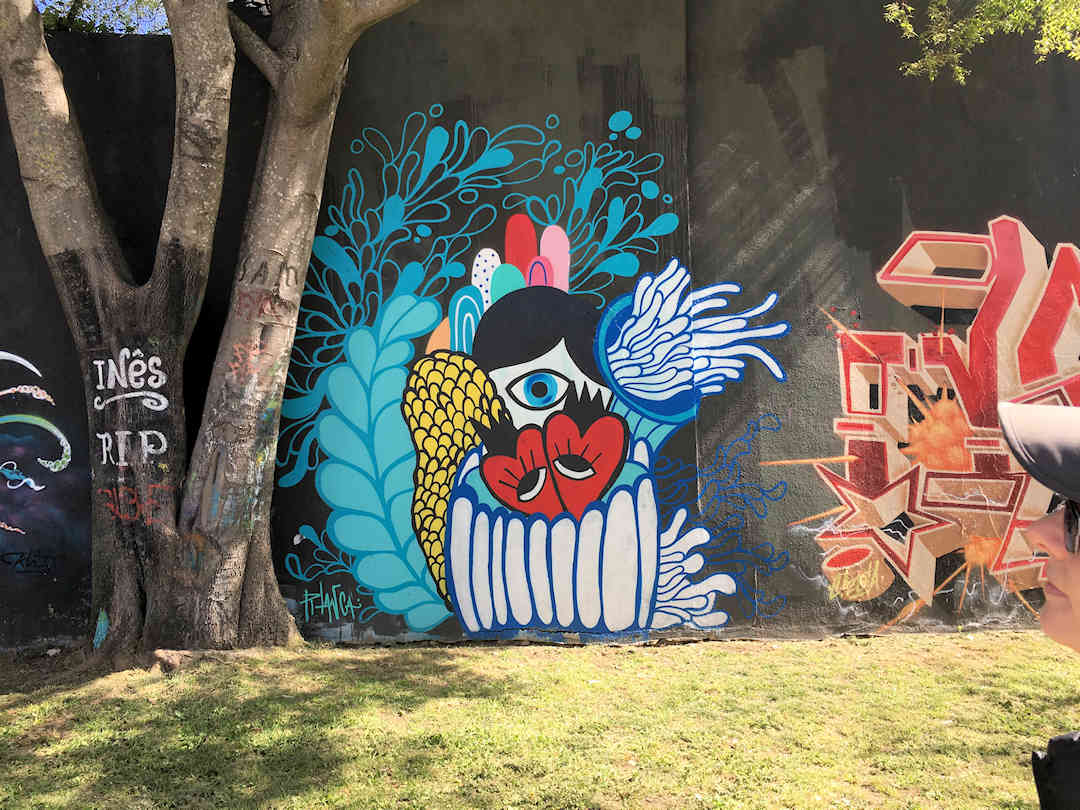
Keep your eyes open, and you will spot great wall art everywhere in Lisbon
Genuine street art enthusiasts will also enjoy the Banksy Museum [Google location], which houses more than 100 of Banksy’s artworks – although it’s not the cheapest. Visit when it opens as it’s least crowded then.
When is the best time to visit Lisbon and Sintra?
While the Portuguese capital (with nearby Sintra) is a destination available all year round, we recommend visiting in Spring (March to May) or Autumn (September to November) when the weather is most pleasant. Winter (December to February) is also a good option if you don’t mind the colder temperatures and occasional rainy days. The peak Summer months (June to August) are best avoided as the city can be too hot for comfort and will be packed with tourists.
To learn more about the weather in Lisbon all year round, check out Weatherspark.
10. Marvel exceptional artworks at Museu Calouste Gulbenkian
And to finish off on the topic of art…
If you’re an art lover, visiting the Museu Calouste Gulbenkian is a MUST when in Lisbon. Housed in a modernist complex of buildings set in a beautiful landscaped garden, this private collection features artworks from Ancient Egypt to the 20th century (including works by Rembrandt, Rubens, van Dyck, Rodin, Renoir, Manet, Monet and Degas).
Bonus: Entry to the museum is free on Sundays after 14:00.

Art lovers will also enjoy the exceptional private collection of the Calouste Gulbenkian Museum | Image courtesy of Rui Alves on Unsplash
Lisbon is one of those places where you could easily live for a month or more, immerse yourself, take some language lessons, and just explore. If you love photography, there are so many things to capture: widows in their black clothes keeping watch from windows or chatting to neighbours, colourful azulejo façades, old abandoned houses with collapsed roofs, stunning sunrises and sunsets.
Have you visited Lisbon and/or Sintra?
If you’ve been to or done any of the above, which one was your favourite? What other affordable and lesser-known things to see and do in Lisbon and/or Sintra would you add to our list?
Before you go, if you liked our article and found it helpful, we would appreciate it if you could share it with your friends and family via the Share buttons below. Even better: Leave a short review on Trustpilot or Google, which would help us further build our online reputation as a (trustworthy and helpful) travel and lifestyle blog.


